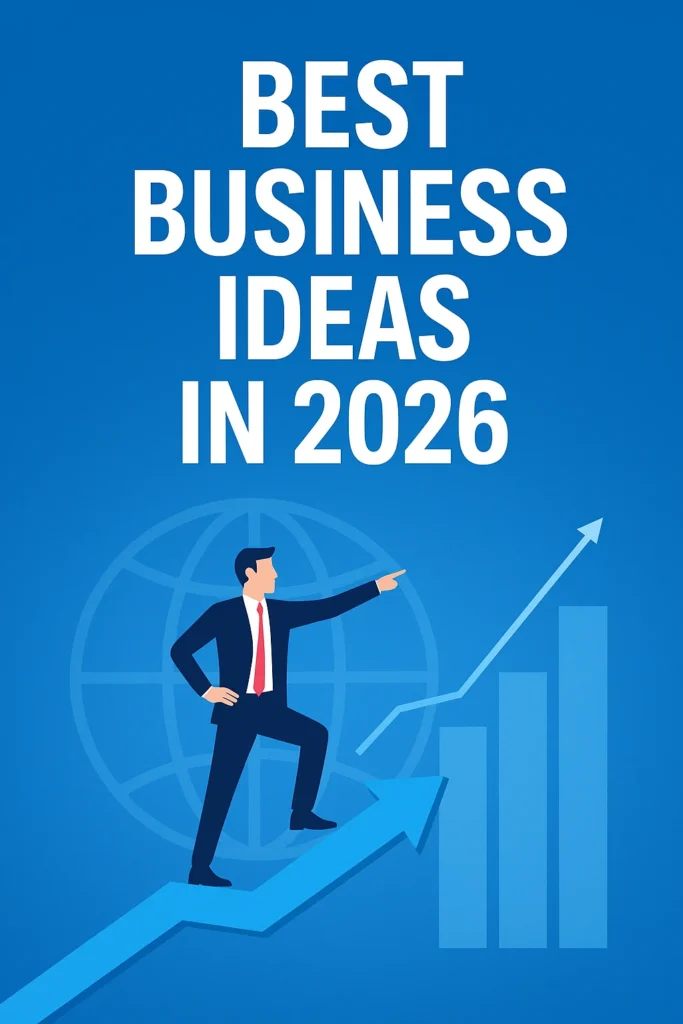2026 isn’t just another business year; it’s a pivot point. Emerging technologies like AI and 5G, combined with global demand for sustainability and remote services, create rich ground for new ventures. Between shifts in remote work, tightening environmental regulations, and changing consumer expectations across the U.S., U.K., Canada, EU, Australia, and beyond, entrepreneurs poised to innovate will find wide latitude.
This article outlines the best business ideas in 2026, each grounded in current trends, tailored for Tier 1 markets, and scalable worldwide. We focus on ideas that are original, strategic, and lasting, not fleeting fads.
1. AI-Powered Services and Automation
Generative AI Consulting & Custom Tools
With generative AI revolutionizing creative workflows and forecasted to drive a major shift in business models specialists who build custom AI assistants, content systems, or automation tools for legal, marketing, education, and finance sectors will stand out. Offering tailored solutions (e.g. AI chatbot for travel planning or business proposal generation) combines scalability with high value.
AI-Personalized Education Platforms
Online education businesses offering AI-adaptive learning modules (e.g., Math coach for exam prep or language fluency tools) fill a growing niche. These platforms deliver efficient, tailored learning one reason EduTech continues to boom.
2. Sustainable & Green Businesses with Global Appeal
Carbon Accounting for SMBs
Regulatory shifts in sustainability reporting are coming fast not just for large companies, but SMBs too. Offering carbon tracking and offsetting solutions (online SaaS) positions you at the intersection of regulation and purpose.
Reusable Packaging Solutions
As global markets shift from single-use plastics, businesses that enable affordable, scalable reusable packaging, particularly modular or smart-return systems hold massive potential, especially selling B2B to e-commerce brands.
3. Remote-First Economy Platforms
Niche Talent Marketplaces
Generalist freelance platforms are crowded. In 2026, segmented marketplaces for remote healthcare professionals, sustainability consultants, or ed-tech mentors will command higher trust and margins. These services align with global remote work trends.
Remote Work Tools & Management Systems
As remote and hybrid work proliferate, tools that assist with task collaboration, distributed onboarding, or virtual culture-building are vital. Opportunities exist for affordable tools tailored to small/mid-sized firms in Tier 1 markets.
4. Health & Wellness Tech
Mental Health Platforms with AI Support
Digital mental health platforms are expanding fast, especially when they use AI for guided therapy, mood tracking, or telemedicine. These can scale internationally and are especially relevant in post-pandemic awareness.
Longevity & Wellness Services
As global populations age, services catering to active living, wellness coaching, or customizable health regimens (even delivered via mobile or app-based platforms) offer long-term growth.
5. Specialized E-Commerce & Cultural Marketplaces
Curated Heritage Goods
Platforms selling region-specific or artisanal goods (e.g., Indian crafts or Nordic textiles) to global buyers offer both authenticity and digital convenience, something global consumers increasingly crave.
Micro-Subscription Boxes
Subscription boxes (e.g., wellness kits, global snacks, niche book clubs) remain popular but personalization and limited editions foster loyal followings. These work especially well in Tier 1 countries.
6. Senior Care & Longevity Economy
Population aging is a global trend:
- Home Tech for independent living (smart sensors, fall notifications)
- Concierge services targeting retirees or remote families
- Senior-focused online platforms for wellness or community
7. Cybersecurity as a Global Need
With remote work and AI’s prevalence expanding hacking risks, affordable cybersecurity tools for SMEs, remote teams, or managed security services are ripe opportunities.
8. Web3 & Digital Asset Consulting (Cross-Border)
While niche, Web3 remains a trend. Consulting for NFT drops, token-based loyalty programs, or virtual real estate in the metaverse tied into global audiences can be lucrative if viewed prudently.
9. Low-Investment, High-Reward Global Options
For entrepreneurs seeking low upfront costs:
| Business Idea | Why It Works Globally |
| Online tutoring services | Digital delivery, subject expertise, minimal tools |
| Virtual assistance services | Remote demand in admin or creative tasks |
| Podcast editing & production | Low overhead, scalable via bundle services |
| Pet care (mobile) | Growing pet industry in Tier 1 markets |
| Mobile notary / concierge | Minimal equipment, high per-job value |
These options reflect real-world low-investment ideas referenced by Investopedia, globally viable yet flexible.
How to Launch Right in 2026
- Validate demand → keyword research + competitor intel
- Launch MVP (Minimum Viable Product): offer pilot services or proof-of-concept
- Gather feedback → iterate quickly, using customer data to refine
- Plan for scaling → online infrastructure, multilingual support, global payment methods
Funding Paths in 2026
- Bootstrapping with global freelance services
- Crowdfunding platforms using global audiences
- Revenue-based financing and small grants for green/AI tech startups
- Angel networks (e.g. Techstars, Seedcamp with global reach)
Ensure you choose funding aligned with your global service model, and always respect investor region-specific terms and regulatory compliance.
Build for the Future, Not Just 2026
In 2026, successful businesses will align with enabling technologies (AI, digital), global sustainability demands, and distributed markets. Ideas like carbon accounting SaaS, AI-personalized education, curated global platforms, or mental health tools tap enduring needs. Launch them early, validate fast, and keep improving.

